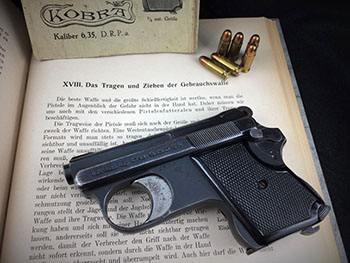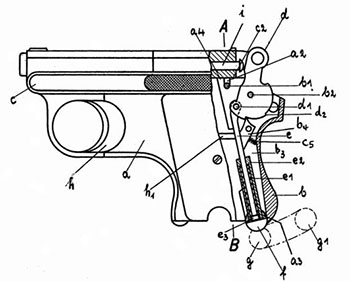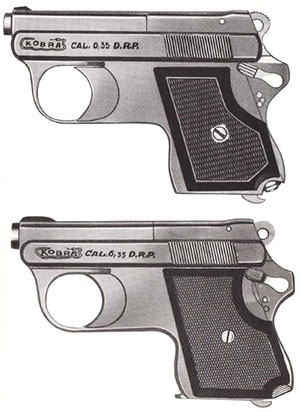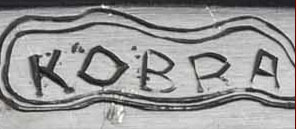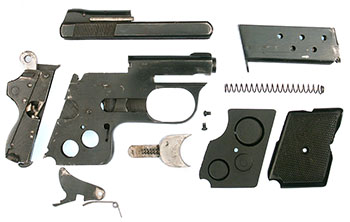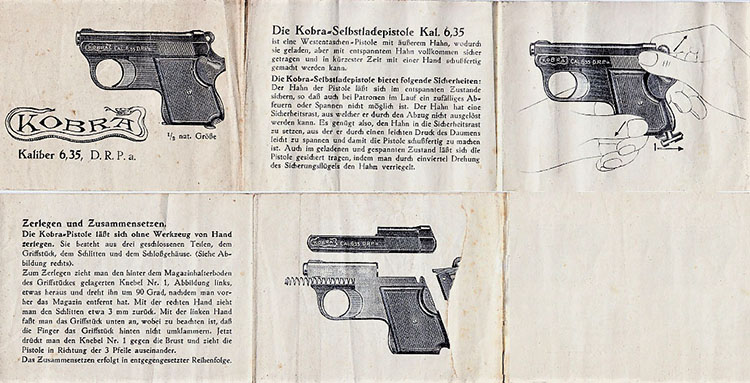Biting Beast – The Kobra Pistol
by Dr. Stefan Klein
When a cobra is threatened, it raises the upper body, biting at lightning speed or spewing its venom a few feet away with deadly precision. Perhaps it were these qualities that prompted
gunsmith Walter Diefke in 1934 to designate his new 6.35 mm Browning pocket pistol after the defensive venomous snake. Even at first glance, the Kobra is a quite remarkable construction, because
its hammer distinguishes it from competing products of its time.
Patents and Technology
If you are looking for patents by Walter Diefke, you will find only a short list: in 1922 a Tesching (small-bore rifle) with straight pull bolt action (DRP365338) and in 1954 a blank cartridge
(DE1699603). The latest invention hints at Diefke's post-war commitment. With his company named Diemuni (Diefke Munition), then later Wadie (Walter Diefke), the gunsmith has
concentrated on the production of gas and blank pistols since the 1950s. Today the ammunition factory DIEFKE WADIE MUNITION GmbH & Co. KG produces irritant ammunition and distributes blank guns.
But let us return to the Kobra pistol. Diefke used a patent from Friedrich Schüler (DRP 597020), published on April 26, 1934. It is worth noting that almost the entire lockwork in this design is located
in a separate housing. The frame is open at the back (Fig. 2). The lockwork housing is hooked in the frame by the help of two pivots (b1) at its upper end. The lower end of the housing has a
knob (f), which is connected to the hammer strut (e2). The knob is under tension of the hammer spring (e1) and can be pulled down from the housing against the spring tension. On the
underside of the frame there are two recesses into which the knob engages. The housing is fixed in the frame by the pivots and the knob, under tension from the hammer spring. At the same time, the
pivots run in the inner longitudinal grooves of the slide and thus hold the lockwork housing perpendicular to the direction of the slide’s backward movement.
Schüler mitigated the risk that the hammer might ignite a cartridge as a result of an accidental drop. The hammer of the loaded but uncocked pistol can be placed in a “half-cock” safety position. From
this position, the hammer cannot be released by the trigger. If necessary, a slight pressure on the hammer is enough to make the pistol ready to fire. In loaded and cocked condition a rotating safety lever blocks the hammer.
Advertisements for the Kobra pistol are rare (Fig. 3). In the biweekly magazine Der Waffenschmied, the official organ of the Reich Federation of German gunsmiths, weapon and ammunition
dealers, one finds only two ads for the Kobra Pistol in 1934. The first advertisement dates from April 14, 1934, which correlates quite well with the publication date of the patent
(April 26, 1934). Before launching the Kobra on the market, a certain number of pistols must have been produced in order to be able to fill orders quickly. These weapons bear the
inscription "D.R.P. a. "(Deutsches Reich Patent angemeldet = applied for). With later weapons one finds only "D.R.P." To what extent the Gewehrfabrik Albert Büttner was involved in the
production of the Kobra, I have been unable to clarify. Perhaps Büttner was only a commission agent.
Accurate production figures for the Kobra are not available. Schönbauer mentions that only small quantities were produced. In the years of my collecting activity I
have observed very few pieces, none beyond serial number 1826. If one assumes a continuous numbering starting from zero, then approximately 2,000 pistols would have been produced. I appreciate it if readers
would share their serial numbers with me so I can make a more accurate estimate.
Variants
Due to the low production figures and the few observed pieces, the number of proven variants is low. Pawlas shows two different designs, which differ slightly in the
checkering of the hammer, the length of the front sight, the checkering of the grips, and the shape of the knob (Fig. 4).
However, I have not been able to find any reference
samples for the upper weapon. The earliest known Kobra with serial number 813 already has the characteristics of the lower weapon. König and Hugo also show a pistol with a grip medallion on the right grip.
There are two variants. These differ in the lettering on the left side of the slide.
KOBRA CAL. 6,35 D.R.P.a.
and
KOBRA CAL. 6,35 D.R.P.
The word "KOBRA" is enclosed by a circumferential double line open at the top, which turns out to be a stylized cobra on closer examination. The early pistol
with serial number 813 is unusual in that the word KOBRA appears to have been hand engraved and the engraver was not up to creating the cobra, so it is simply two lines that encircle the word.
Disassembly and Reassembly
The Kobra is relatively easy to disassemble. Make sure the pistol is empty. First, pull out the knob and turn it 90° so that it comes loose from the recesses at the bottom of the frame and rests on the housing.
Then pull the slide a few millimeters back so that it can slide out of the recesses in the longitudinal grooves of the slide. In this position, the housing can then pulled with a rotary movement toward the
rear top of the frame. In theory, that is easy. In practice, you may require a third hand. The instructions recommend pulling back the slide with
your right hand, pulling the grip in the direction of the muzzle with your left hand and using the chest as a rest for the knob.
|
Technical Data
|
|
Caliber
|
6.35 mm Browning
|
Height
|
78 mm
|
|
Barrel Length
|
59mm (4 grooves, right)
|
Width
|
22 mm
|
|
Weight (empty)
|
350 g
|
Magazine Capacity
|
6 cartridges
|
|
Length
|
116 mm
|
Grip Material
|
Hard Rubber
|
|
|
|
|
References
- König, Klaus-Peter und Hugo, Martin. Taschen- und Miniaturpistolen. Eine Auswahl aus 100 Jah-ren, Stuttgart, 1985.
- Pantermühl, Axel. „Auch mit Lavendelduft. Lacrimae-Patronen gab es in drei Varianten: Gas, Platz, Parfüm.“ Deutsches Waffenjournal, Nr. 10 (2004): 58-63.
- Pawlas, Karl R. „Die Kobra Selbstladepistole“. Waffen Revue, Nr. 63 (1986): 33-38.
- Pawlas, Karl R. Pistolenatlas. Archiv für Militär und Waffenwesen, Band 2, Nürnberg, 1970.
- Schönbauer, Gerhard. „Der Taschenpistolen-Sammler”. http://www.vestpockets.bauli.at/.
Thanks to Ed Buffaloe for assistance with English language editing.
|
|
|


